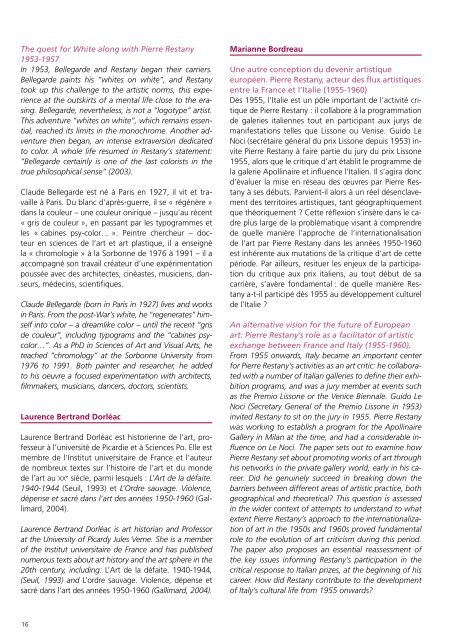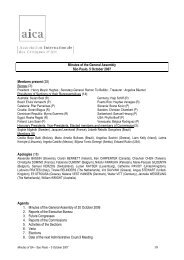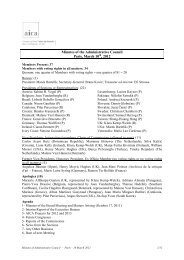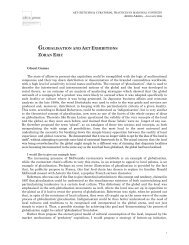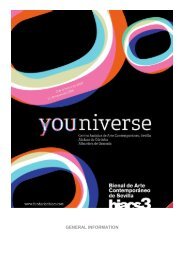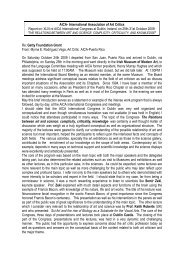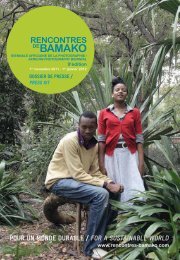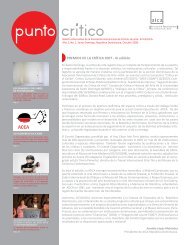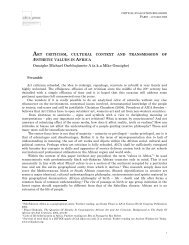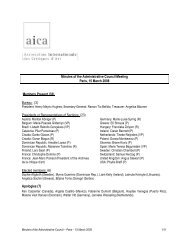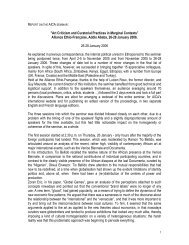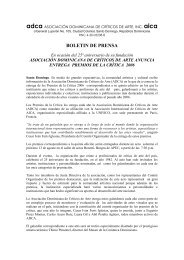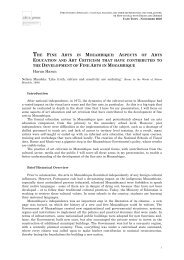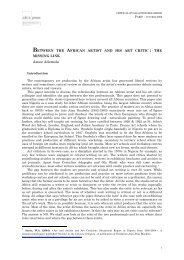Pierre Restany Pierre Restany's - AICA international
Pierre Restany Pierre Restany's - AICA international
Pierre Restany Pierre Restany's - AICA international
Create successful ePaper yourself
Turn your PDF publications into a flip-book with our unique Google optimized e-Paper software.
The quest for White along with <strong>Pierre</strong> <strong>Restany</strong><br />
1953-1957<br />
In 1953, Bellegarde and <strong>Restany</strong> began their carriers.<br />
Bellegarde paints his “whites on white”, and <strong>Restany</strong><br />
took up this challenge to the artistic norms, this experience<br />
at the outskirts of a mental life close to the erasing.<br />
Bellegarde, nevertheless, is not a “logotype” artist.<br />
This adventure “whites on white”, which remains essential,<br />
reached its limits in the monochrome. Another adventure<br />
then began, an intense extraversion dedicated<br />
to color. A whole life resumed in <strong>Restany</strong>’s statement:<br />
“Bellegarde certainly is one of the last colorists in the<br />
true philosophical sense” (2003).<br />
Claude Bellegarde est né à Paris en 1927, il vit et travaille<br />
à Paris. Du blanc d’après-guerre, il se « régénère »<br />
dans la couleur – une couleur onirique – jusqu’au récent<br />
« gris de couleur », en passant par les typogrammes et<br />
les « cabines psy-color… ». Peintre chercheur – docteur<br />
en sciences de l’art et art plastique, il a enseigné<br />
la « chromologie » à la Sorbonne de 1976 à 1991 – il a<br />
accompagné son travail créateur d’une expérimentation<br />
poussée avec des architectes, cinéastes, musiciens, danseurs,<br />
médecins, scientifiques.<br />
Claude Bellegarde (born in Paris in 1927) lives and works<br />
in Paris. From the post-War’s white, he “regenerates” himself<br />
into color – a dreamlike color – until the recent “gris<br />
de couleur”, including typograms and the “cabines psycolor…”.<br />
As a PhD in Sciences of Art and Visual Arts, he<br />
teached “chromology” at the Sorbonne University from<br />
1976 to 1991. Both painter and researcher, he added<br />
to his oeuvre a focused experimentation with architects,<br />
filmmakers, musicians, dancers, doctors, scientists.<br />
Laurence Bertrand Dorléac<br />
Laurence Bertrand Dorléac est historienne de l’art, professeur<br />
à l’université de Picardie et à Sciences Po. Elle est<br />
membre de l’Institut universitaire de France et l’auteur<br />
de nombreux textes sur l’histoire de l’art et du monde<br />
de l’art au xx e siècle, parmi lesquels : L’Art de la défaite.<br />
1940-1944 (Seuil, 1993) et L’Ordre sauvage. Violence,<br />
dépense et sacré dans l’art des années 1950-1960 (Gallimard,<br />
2004).<br />
Laurence Bertrand Dorléac is art historian and Professor<br />
at the University of Picardy Jules Verne. She is a member<br />
of the Institut universitaire de France and has published<br />
numerous texts about art history and the art sphere in the<br />
20th century, including: L’Art de la défaite. 1940-1944,<br />
(Seuil, 1993) and L’ordre sauvage. Violence, dépense et<br />
sacré dans l’art des années 1950-1960 (Gallimard, 2004).<br />
Marianne Bordreau<br />
Une autre conception du devenir artistique<br />
européen. <strong>Pierre</strong> <strong>Restany</strong>, acteur des flux artistiques<br />
entre la France et l’Italie (1955-1960)<br />
Dès 1955, l’Italie est un pôle important de l’activité critique<br />
de <strong>Pierre</strong> <strong>Restany</strong> : il collabore à la programmation<br />
de galeries italiennes tout en participant aux jurys de<br />
manifestations telles que Lissone ou Venise. Guido Le<br />
Noci (secrétaire général du prix Lissone depuis 1953) invite<br />
<strong>Pierre</strong> <strong>Restany</strong> à faire partie du jury du prix Lissone<br />
1955, alors que le critique d’art établit le programme de<br />
la galerie Apollinaire et influence l’Italien. Il s’agira donc<br />
d’évaluer la mise en réseau des œuvres par <strong>Pierre</strong> <strong>Restany</strong><br />
à ses débuts. Parvient-il alors à un réel désenclavement<br />
des territoires artistiques, tant géographiquement<br />
que théoriquement Cette réflexion s’insère dans le cadre<br />
plus large de la problématique visant à comprendre<br />
de quelle manière l’approche de l’<strong>international</strong>isation<br />
de l’art par <strong>Pierre</strong> <strong>Restany</strong> dans les années 1950-1960<br />
est inhérente aux mutations de la critique d’art de cette<br />
période. Par ailleurs, resituer les enjeux de la participation<br />
du critique aux prix italiens, au tout début de sa<br />
carrière, s’avère fondamental : de quelle manière <strong>Restany</strong><br />
a-t-il participé dès 1955 au développement culturel<br />
de l’Italie <br />
An alternative vision for the future of European<br />
art: <strong>Pierre</strong> <strong>Restany</strong>’s role as a facilitator of artistic<br />
exchange between France and Italy (1955-1960).<br />
From 1955 onwards, Italy became an important center<br />
for <strong>Pierre</strong> <strong>Restany</strong>’s activities as an art critic: he collaborated<br />
with a number of Italian galleries to define their exhibition<br />
programs, and was a jury member at events such<br />
as the Premio Lissone or the Venice Biennale. Guido Le<br />
Noci (Secretary General of the Premio Lissone in 1953)<br />
invited <strong>Restany</strong> to sit on the jury in 1955. <strong>Pierre</strong> <strong>Restany</strong><br />
was working to establish a program for the Apollinaire<br />
Gallery in Milan at the time, and had a considerable influence<br />
on Le Noci. The paper sets out to examine how<br />
<strong>Pierre</strong> <strong>Restany</strong> set about promoting works of art through<br />
his networks in the private gallery world, early in his career.<br />
Did he genuinely succeed in breaking down the<br />
barriers between different areas of artistic practice, both<br />
geographical and theoretical This question is assessed<br />
in the wider context of attempts to understand to what<br />
extent <strong>Pierre</strong> <strong>Restany</strong>’s approach to the <strong>international</strong>ization<br />
of art in the 1950s and 1960s proved fundamental<br />
role to the evolution of art criticism during this period.<br />
The paper also proposes an essential reassessment of<br />
the key issues informing <strong>Restany</strong>’s participation in the<br />
critical response to Italian prizes, at the beginning of his<br />
career. How did <strong>Restany</strong> contribute to the development<br />
of Italy’s cultural life from 1955 onwards<br />
16


